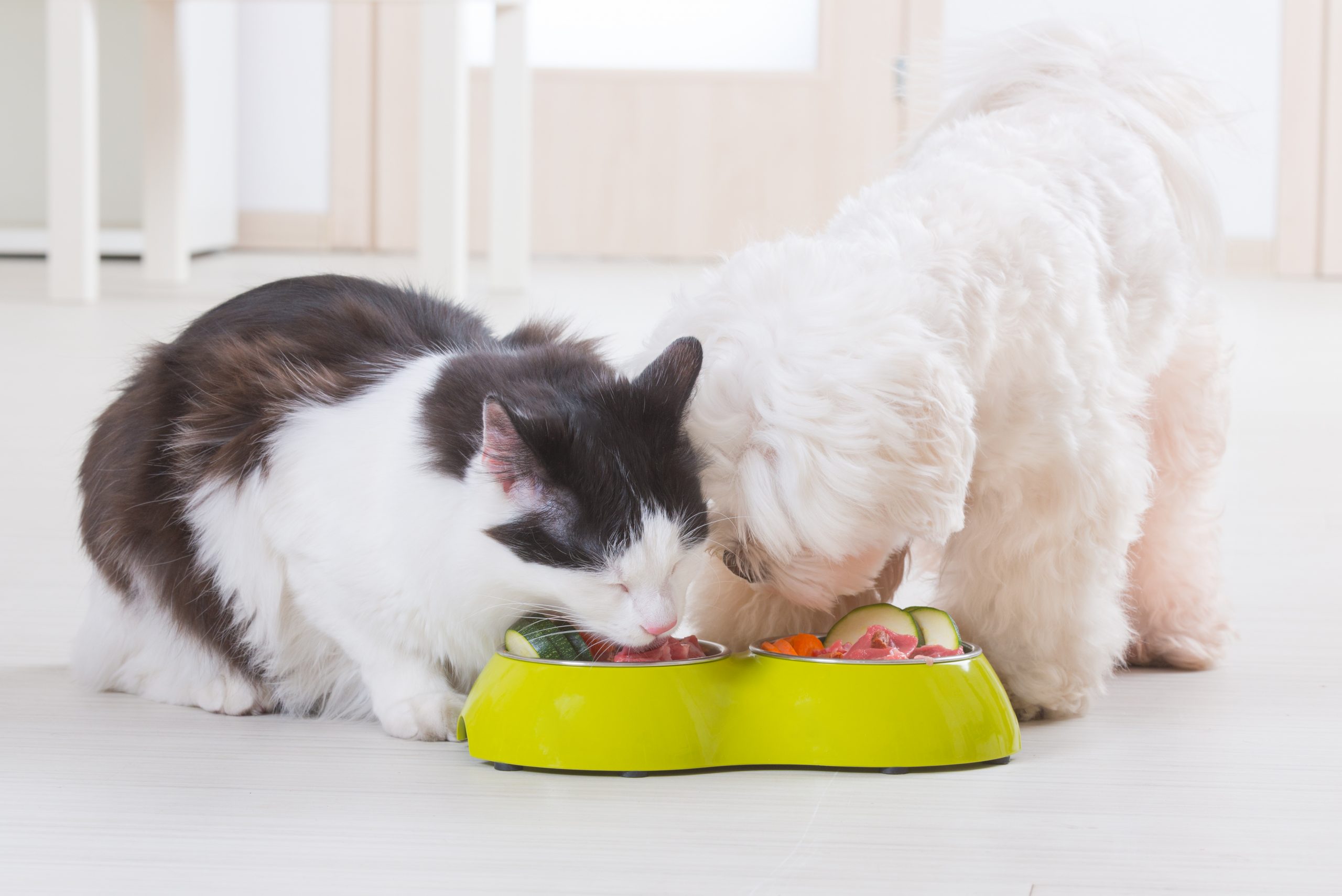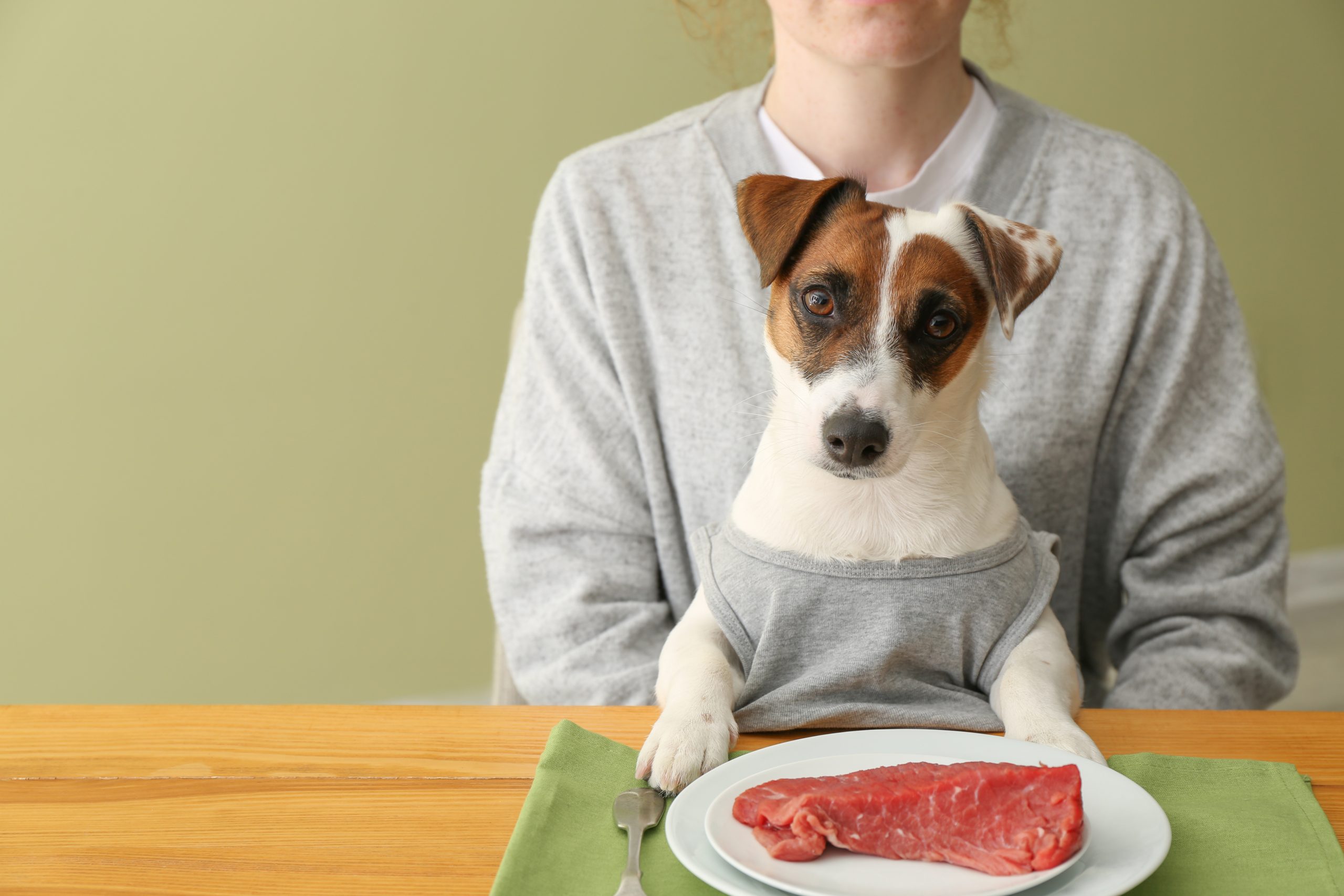Pet food trends typically follow those in human nutrition. We saw that with the grain-free fad, and now more and more diets are touting human-grade, organic, or all-natural ingredients. Since pets are treated as cherished family members, pet owners want to ensure their furry companions have the best possible diet that is on par with their own. Whether these human-grade diets have true health benefits has yet to be determined through sound scientific research, but anecdotal evidence claims they provide innumerable perks.
Raw diets are currently gaining in popularity for pets. They can be tailored for cats or dogs, and typically consist of a combination of raw meat and other uncooked foods, such as fruits and vegetables.
Why are raw diets for pets so popular?
Raw diets are becoming widespread because pet owners see them as a more natural option to traditional pet food. Raw food advocates also surmise that because dogs evolved from wolves, and cats evolved from the African wild cat, today’s pets should eat what their wild ancestors ate—namely, carcasses. However, our domesticated pets broke away from their wild predecessors thousands of years ago, and have had ample time for evolution. While cats are still obligate carnivores, meaning they must eat meat to survive, dogs are omnivores and can easily digest a wide variety of foods.
…our domesticated pets broke away from their wild predecessors thousands of years ago, and have had ample time for evolution.
Raw diets are also growing in popularity because of the thinking that all the nutrients are cooked out of traditional kibble. Important vitamins, minerals, amino acids, and enzymes that were cooked out of the meat during processing need to be added back—which pet food manufacturers do. But, with raw food diets, the meat is not processed and cannot lose valuable nutrients.
So, despite evolutionary facts, raw diets have gained a strong foothold in the pet-food industry, as pet owners look to feed a natural diet. And, while no substantial research exists, a raw diet does appear to have some benefits. However, all the benefits are currently based on individual experience, so keep that in mind when considering switching your pet to a raw diet.
What are the benefits of feeding my pet a raw diet?
Pet owners who feed their cats and dogs a raw diet claim they see numerous advantages over traditional kibble. Some of the most widely acclaimed benefits include:
- Glossier hair coat
- Increased energy and stamina
- Improved digestion
- Reduction or elimination of skin issues (e.g., dry skin, itching, allergies)
- Smaller and less odorous stool
- Healthier weight
- Improved breath and dental hygiene
- Decreased risk for diabetes, allergies, cancer, and other serious diseases
Many people like that they have complete control over their pet’s food, since they know exactly the ingredients in the diet. The ability to adjust the diet to their pet’s specific needs is a huge plus.

What are the drawbacks to feeding my pet a raw diet?
Raw feeding can pose a lot of problems, especially when prepared at home without the aid of a veterinary nutritionist. A lot more is involved in a raw diet than simply tossing your pet a bone from the butcher. Without balancing the nutrient content of the diet correctly, your pet could become seriously ill.
In addition, raw food, especially meat, contains bacteria, parasites, and other pathogens that would normally be killed during the cooking process. Although pets are less susceptible to the bacterial pathogens in food, they can still contract E. coli, salmonella, or tuberculosis. And, a pathogen that a pet ingests can be passed on to their owner, or can be contracted by the owner while preparing their diet. Preparing a raw diet for your pet is not a good idea if anyone in your home is immunocompromised, pregnant, young, or old.
Bones are another raw food hazard, although an uncooked bone is less likely to splinter than a cooked one. Chewing on bones can fracture your pet’s teeth, while small fragments can become lodged in their gastrointestinal tract.
How can I formulate a balanced raw diet for my pet?
A balanced raw diet for your pet should only be formulated with a veterinary nutritionist’s help, to ensure your four-legged friend receives the correct ratio of vitamins, minerals, and other nutrients. A pet’s raw diet should be created with the following proportions:
A balanced raw diet for your pet should only be formulated with a veterinary nutritionist’s help, to ensure your four-legged friend receives the correct ratio of vitamins, minerals, and other nutrients.
- Muscle meat should make up 35% to 50% of your pet’s diet — Muscle meat is the key source of protein, as well as amino acids and other important nutrients. Common meats used in raw diets include chicken, beef, fish, lamb, turkey, pork, rabbit, squirrel, and venison.
- Organ meat should make up 10% to 30% — Organ meats provide excellent nutrition for your pet, but variety is key. Add varying amounts of liver, heart, kidneys, spleen, lungs, or tripe to your pet’s diet. Avoid feeding your pet all liver as their organ meat, as too much vitamin A can make them ill.
- Bone should make up 10% to 15% — Although the general consensus among raw-diet advocates is that uncooked bones are typically safe for pets, you can prevent fractured teeth and gastrointestinal obstructions by feeding bone meal. However, always buy bone meal from a grocer, rather than hardware or garden stores, whose products can contain fertilizers. You can also grind bones in a meat grinder to aid your pet’s digestion, especially if you’re using whole chicken or fish carcasses. Whole raw eggs also contribute to the bone portion of your pet’s diet, as eggshells are rich in the calcium needed from bones.
- Fat should make up 10% to 20% — The meats in your pet’s diet will provide the fat, but feed meats that are 80% to 90% lean to limit the amount of fat.
Fruits and veggies also are welcomed in raw diets, but moderation is key. Berries, green beans, broccoli, cauliflower, carrots, squash, kale, spinach, radishes, and beets make excellent additions, whereas most grains and other carbohydrate sources, like peas and potatoes, are typically excluded. A raw diet should mostly be based on meaty bones with a small amount of fresh fruits and veggies.
To ensure your pet receives adequate nutrients, consider adding a vitamin and mineral supplement to their diet. Not only do properly formulated supplements provide the correct nutrient ratio, but they are also packed with healthy fats and essential fatty acids to guarantee a shiny coat and joint health. Hale Animal Health supplements are specially formulated to complement your pet’s base diet, and would be a great addition to a raw diet.

How can I safely feed my pet a raw diet?
Feeding your pet a raw diet that you prepare at home can be done safely, if you keep the following safety tips in mind:
- Separation — Separate the bowls and cutlery you use to prepare or handle raw food from the rest of your utensils.
- Cleanliness — Washing after food preparation is essential.
- Always wash your hands before and after handling your pet’s food.
- Wash and sanitize everything thoroughly after preparing the food and feeding your pet.
- Remember that your pet’s saliva and feces can contain potentially dangerous bacteria if they are fed a raw diet, so wash your hands after touching your pet and prevent them from licking you.
Before switching your pet to a raw diet, check with your veterinarian. Some medical conditions preclude pets from eating raw meat, especially if they’re immunocompromised. But, when fed properly, a raw diet may benefit your four-legged friend’s coat, digestion, and oral health, and ward off certain diseases. Have the raw diet discussion with your veterinarian to see if your pet is a good candidate for a diet change.

